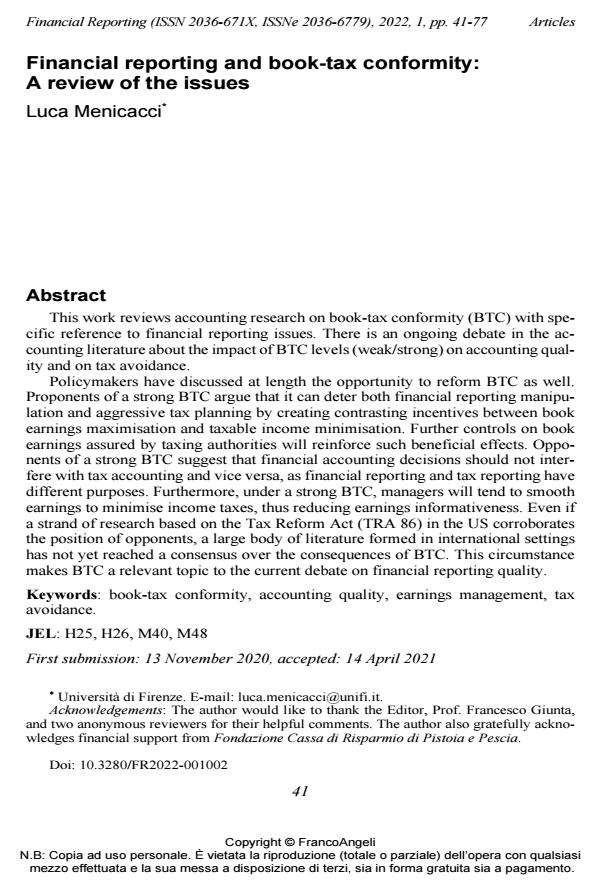Financial reporting and book-tax conformity: A review of the issues
Titolo Rivista FINANCIAL REPORTING
Autori/Curatori Luca Menicacci
Anno di pubblicazione 2022 Fascicolo 2022/1
Lingua Inglese Numero pagine 37 P. 41-77 Dimensione file 217 KB
DOI 10.3280/FR2022-001002
Il DOI è il codice a barre della proprietà intellettuale: per saperne di più
clicca qui
Qui sotto puoi vedere in anteprima la prima pagina di questo articolo.
Se questo articolo ti interessa, lo puoi acquistare (e scaricare in formato pdf) seguendo le facili indicazioni per acquistare il download credit. Acquista Download Credits per scaricare questo Articolo in formato PDF

FrancoAngeli è membro della Publishers International Linking Association, Inc (PILA)associazione indipendente e non profit per facilitare (attraverso i servizi tecnologici implementati da CrossRef.org) l’accesso degli studiosi ai contenuti digitali nelle pubblicazioni professionali e scientifiche
This work reviews accounting research on book-tax conformity (BTC) with specific reference to financial reporting issues. There is an ongoing debate in the accounting literature about the impact of BTC levels (weak/strong) on accounting quality and on tax avoidance. Policymakers have discussed at length the opportunity to reform BTC as well. Proponents of a strong BTC argue that it can deter both financial reporting ma-nipulation and aggressive tax planning by creating contrasting incentives between book earnings maximisation and taxable income minimisation. Further controls on book earnings assured by taxing authorities will reinforce such beneficial ef-fects. Opponents of a strong BTC suggest that financial accounting decisions should not interfere with tax accounting and vice versa, as financial reporting and tax reporting have different purposes. Furthermore, under a strong BTC, managers will tend to smooth earnings to minimise income taxes, thus reducing earnings in-formativeness. Even if a strand of research based on the Tax Reform Act (TRA 86) in the US corroborates the position of opponents, a large body of literature formed in international settings has not yet reached a consensus over the conse-quences of BTC. This circumstance makes BTC a relevant topic to the current de-bate on financial reporting quality.
Parole chiave:book-tax conformity, accounting quality, earnings management, tax avoidance.
Jel codes:H25, H26, M40, M48
- Do female auditors affect accruals quality? A replication and extension of Ittonen, Vahamaa, and Vahamaa (2013) Camilla Ciappei, Claudia Frisenna, Diletta Vianello, in FINANCIAL REPORTING 2/2024 pp.77
DOI: 10.3280/FR2024-002004 - Mafia ties and financial reporting quality spillovers: Evidence from private firms in Italy Pietro A. Bianchi Fedrigoni, Nicola Pecchiari, in FINANCIAL REPORTING 2/2025 pp.59
DOI: 10.3280/fr202519624 - Unintended consequences of tax incentives on the accounting quality of private firms Massimiliano Bonacchi, Luca Menicacci, in FINANCIAL REPORTING 2/2025 pp.91
DOI: 10.3280/fr202519445 - Tax Avoidance Research Antonio De Vito, Francesco Grossetti, pp.5 (ISBN:978-3-031-51764-8)
Luca Menicacci, Financial reporting and book-tax conformity: A review of the issues in "FINANCIAL REPORTING" 1/2022, pp 41-77, DOI: 10.3280/FR2022-001002